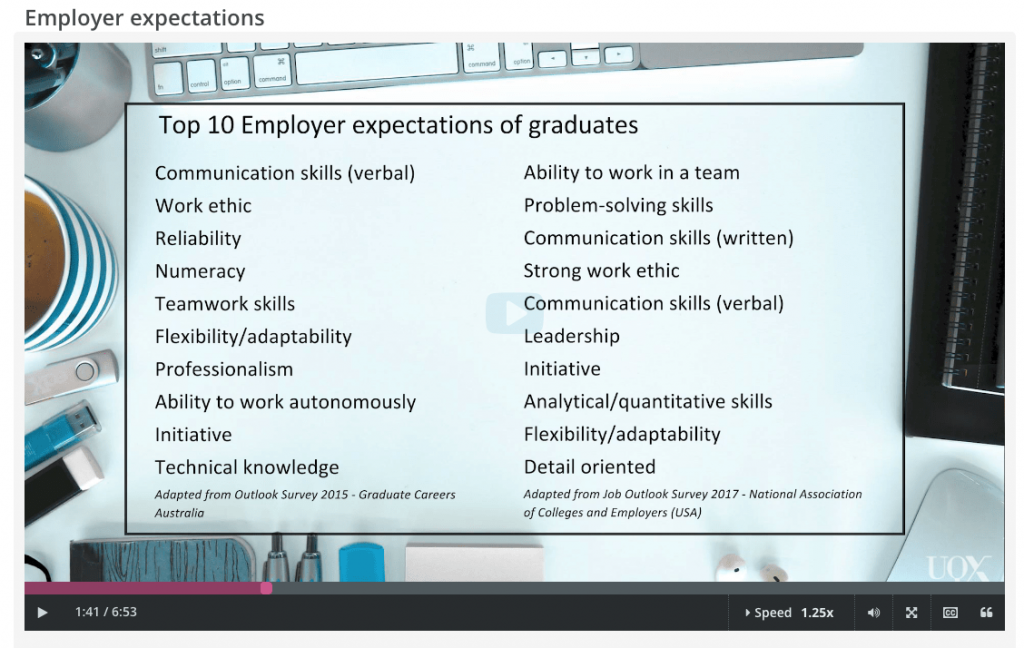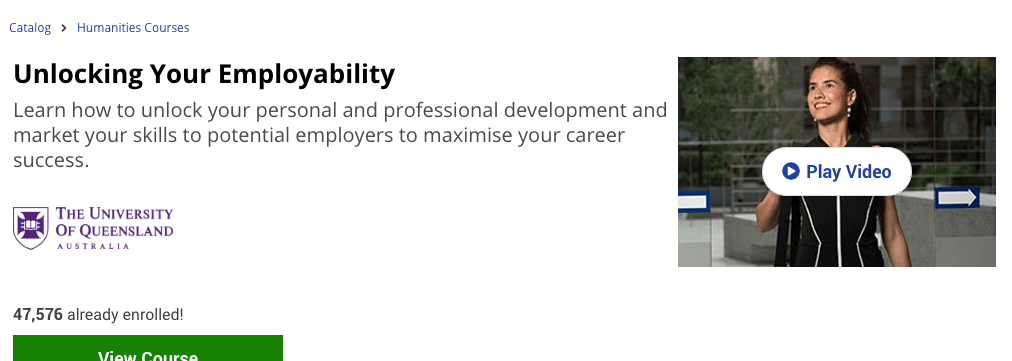I was having a conversation the other day about job hunting strategies. I mentioned how I’d recently taken a new online course and had learned some new and unique approaches to share my past experiences with employers. I’d also learned that there are certain qualities all employers look for, though not every employer priorities these qualities equally.
The course, Unlocking Your Employability, is available from EdX and taught by two career coaches from the University of Queensland in Australia. The course frequently uses interviews from students, graduates, and employers to help explain many of the concepts. There’s also a mock interview.
In all honesty, the course is geared towards college students and recent graduates but I think the lessons could be helpful for experienced people as well. I’ve been working for more years than the intended audience, but I still learned quite a bit.
Overwhelmingly, the course focuses on teaching students how to reflect on past experiences, and to use that reflection during job hunting to demonstrate how the individuality of each job seeker is valuable to employers.
So here are some concepts I learned. This is will be a reference for me, too.
What is Employability
The first part of the course is focused on introducing and defining the term “employability”. I have to admit that I had not heard this word before and it took me a while before I really understood the concept.
Sharing Skills vs Employability
In my experience, when it comes to job hunting, much of what I’ve come across on job hunting strategies focuses on sharing skills and describing “what you did” on a project. One of the employers in the course distinguishes between employability vs employment outcomes, which is a closer concept to what I’ve come across. Employment outcomes is focused on just getting hired, not maintaining a job or emphasizing employee effectiveness.
Employability is about: finding a job, maintaining work, and being effective in the workplace. The course follows the path of reflecting on experiences to convey employability, and using those experiences to be an effective employee.
As the course is focused on employability, there’s more emphasis on the longer term goal of maintaining employment. The course does not emphasize skills growth. The course assumes the student, or job seeker, already has the skills. Instead the focus is on reflecting on your own individual responses in relation to your work and life experiences, and connecting them back to work.
The course focuses on identifying defining moments which can be used to build an employability narrative, which is conveyed to employers using the SEAL method, as discussed next.
STAR vs SEAL, and Behavioral Interviews
One strategy I’ve come across numerous times focuses on use of the STAR method when it comes to sharing your employment experiences. I typically see this advice given to help job seekers prepare to answer behavioral interview questions or even how to describe a project in their portfolio. If you haven’t come across this before, STAR stands for Situation, Task, Action, Result. The idea is that when an interviewer asks a behavioral question, the interviewee gives an answer in the STAR format.
The trouble I’ve had with this advice is that there’s never any instruction provided on how to translate a past experiences into the STAR format, in a way that’s actually meaningful to me. Or an employer. It’s always seemed that it’s just focused on telling the story of what happened, not providing an answer that’s meaningful to employers.
SEAL is the reflective method taught in the course. SEAL stands for Situation, Effect, Action, Learning. SEAL focuses on helping job seekers take a past experience, from work or life, and reflect on it in a way that can be used to convey employability to employers.
Prep for STAR-based behavioral interviews using the SEAL method
The best way to prepare for behavioral interviews is to prep ahead of time using SEAL. The course identified four questions employers are likely to ask in behavioral interviews:
- Tell about overcoming a challenge
- Dealing with conflict in a team
- Managing competing priorities
- Showing initiative
The idea is to think of specific situations that can be used to provide SEAL-based responses to the above questions. Once you’ve got those responses, it’s much less of a challenge to convert those responses into a STAR format. I’ve already started to use the SEAL method to shift my explanations of past projects towards a more reflective approach.
The key to choosing a situation to use in SEAL is to focus on an experience where you learned something. I really liked this approach because it means I’m able to take a situation and turn it into a learning experience that shows off some of my personal capabilities. The SEAL method can transform even a negative experience into something positive.
Identifying Defining Moments to Build an Employability Narrative
An employability narrative is the sum of each person’s individual experiences. It’s not just recapping a story of a series of experiences. When you’re hired by an employer, they’re getting the sum of your experiences not just your skills.
The experiences can come from anywhere, not just jobs. These can include:
- Defining moments (that maybe had a big impact on your job outlook)
- Key development opportunities (such as a volunteer or teaching experience)
- Capabilities and strengths
- Passions, values, beliefs
I think it really helps to spend time reflecting on this in order to build the narrative ahead of time. This part has been harder than I expected; it can be difficult to view yourself objectively.
Employer Expectations and Professionalism
Employer Expectations (aka Core Competencies)
Early in the course, the instructors provide a list of 10 expectations employers have for graduates (or employees). As they described, the list doesn’t change much.

This list probably looks pretty familiar. It’s in nearly every job ad, in one form or another. NACE calls these career competencies, if that helps to clarify. The list of employer expectations can be used by job seekers, using the SEAL method to share examples, and to convey capabilities and strengths.
Professionalism
These core competencies are not the same as professionalism, which focuses on workplace behaviors. The 4 aspects of professionalism identified by the course include:
- Punctuality; Arrive on time
- Dress appropriately
- Work well with others; Team work
- Communication; speaking appropriately
In addition, one of the employers (a nurse) interviewed in this section identified or explained a few other traits, which still fall under the above categories: positive attitude, introducing yourself, not arguing; think of how you address people. These fit under communication and team work. Obviously, some of these will be more important for some jobs vs others.
When I thought about this list, I have to admit that these are not what I would have identified as professionalism. Probably because I assumed professionalism was mostly focused on technical skills. And the course asked students to reflect on unprofessional behaviors we’ve witnessed as well as our own behaviors that we’d now classify as unprofessional.
Career Transitions and Wrap-Up
The last sections of the course focused on putting it all together, even including a mock interview. That was interesting because we were asked if we’d hire the interviewee and then discuss why or why not on the course forum.
There was also a section on discussing opportunities for continuing education. I guess this post is pretty biased towards the sections I found most interesting. Clearly I don’t have a problem with continuing education.
Reflections
The end of the course includes a course evaluation. Some of my thoughts about the course:
I learned more about the qualities that make someone employable, not just professionally but also personally. I also learned about qualities that define professionalism, which no one has ever explained to me before.
I’ve always considered myself to be professional, but I’ve developed a bad habit of being late to many different types of appointments. Most articles about lateness talk about the idea that being late as a sign of disrespect. But if you’re late to everything, including events that have no one there but yourself, that doesn’t make sense.
However, putting it into context that being late is an unprofessional behavior, well that’s not something I’d heard before. I’m sure that this habit has hurt me educationally as well as professionally. Now that I know, I will work harder at not being late because I don’t want people to think of me as unprofessional.
Initially, I did not appreciate the course that much, probably due to not understanding employability. But by the end, I enjoyed it so much that I decided to purchase a verified certificate of completions. It wasn’t too expensive ($59) and I don’t want to lose access to the course materials.
Bonus!
The section on professionalism reminds me of this 1950s video I saw on YouTube called ‘Office Etiquette’. The video is about a young woman who starts a new job after taking some type of typing training course. She spends the rest of the video reflecting on the lessons the typing instructor shared. Many of the lessons focused on employability, competency, and professionalism, though that’s not what they were called.
The instructor gives a little speech that her students seem to remember by heart: First of all know your work. Enjoy it, but also the people you’re working with. Be considerate of them and be considerate of your employer.
I guess this kind of speech meant a lot in the 1950s. To me it sounds a bit vague and kind of corny. I prefer the much longer and clearer lessons of the Edx course. But the overall points about professionalism and core competencies are still the same, even if the communication isn’t so clear.
The video is 13:15.
Resources:
Unlocking Your Employability: https://www.edx.org/course/unlocking-your-employability
The Wikipedia definition of employability is available here: https://en.wikipedia.org/wiki/Employability
Career Competencies on NACE (National Association for Colleges and Employers): https://www.naceweb.org/career-readiness/competencies/career-readiness-defined/
The University of Queensland, Australia: https://www.uq.edu.au/
